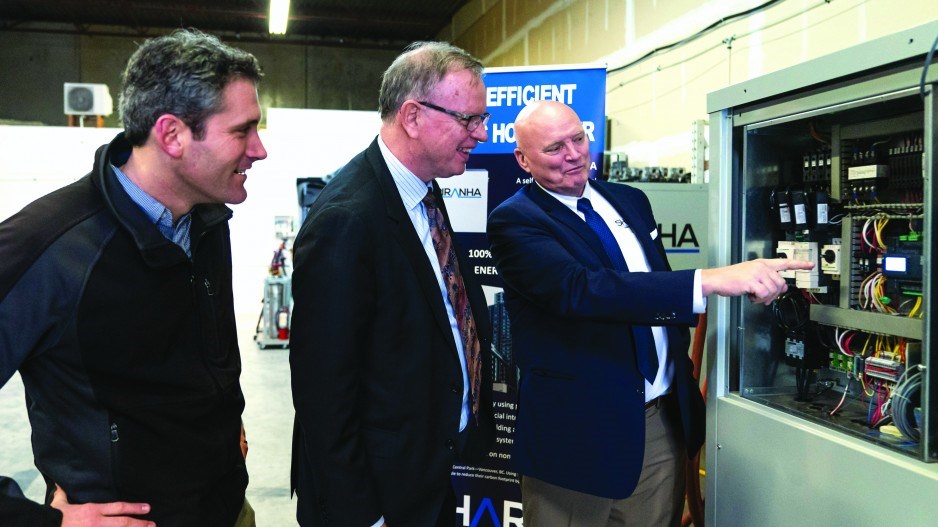A municipal bylaw that will require all new buildings built in Vancouver to be emissions-free is still a decade away from coming into force.
But some developers aren’t waiting for the City of Vancouver’s Zero Emissions Building Plan to require them to adopt low-emissions building.
GN Holdings is one of a handful of developers that have been skipping well ahead of regulations contained in the City of Vancouver’s Renewable City Action Plan by building medium- and high-density residential buildings that don’t require natural gas for space or water heating.
The company recently announced its new 45-unit Ella condo development in East Vancouver will use the building’s own water for thermal energy, using a heat recovery system, called the Piranha, developed locally by Sharc Energy Systems.
It will provide all of the building’s water-heating needs, eliminating the need for natural gas. Space heating will be provided with electrical baseboard heating. That will prevent the emission of about 50 tonnes of carbon dioxide annually that would have otherwise been generated had GN Holdings gone with natural gas for water heating.
The system, which costs about $70,000 — but which may be eligible for a 50 per cent rebate under the CleanBC plan — uses heat exchange to extract thermal energy from the water used in the building. That thermal energy is then used for reheating the water and can also provide air conditioning.
So every time someone in an Ella condo takes a shower, washes clothes, turns on the dishwasher or flushes the toilet, thermal energy will be extracted from the water that goes down the drain before it makes its way into the city’s sewer system. All of that heat stays in the building. No more joules being flushed down the drain.
Matt Ilich, vice-president of development for GN Holdings, said his company looked at other zero-emission systems, such as ground-source heat, but decided the heat recovery system that Sharc builds was the most economic.
Although it will cost more than a natural gas heating system, Ilich said there is demand from environmentally conscious buyers for low-energy, low-emissions living. About 37 of the 45 units have been pre-sold.
In the long run, it may become cheaper for condo owners as carbon taxes increase and both municipal and provincial regulations add to the cost of natural gas by requiring increased use of renewable natural gas content.
“If you look at our buyer profile, we determined it would be millennials,” said Ilich. “So what we wanted to do was go about finding a system that would appeal to millennials but also work with a building of our size. It also allowed us to protect our buyers from future carbon tax increases [and] volatilities in the commodities market.
“I’m 37 years old. I have two little kids. I care deeply about the environment. And I think that is something that we are seeing more and more of from a larger percentage of the buyer pool: they want to buy into something that is environmentally friendly.”
That shift in consciousness is good news for Sharc Energy Systems, which has struggled, since going public three years ago, with accumulated deficits and low share prices.
Although the technology has begun to capture the attention of developers looking for relatively low-cost alternative energy solutions for buildings, it has failed to capture the attention of clean-technology investors, some of whom seem to be more enamoured of more radically ambitious technologies.
“We’re punished for being just too simple,” said Sharc president Lynn Mueller.
Whether it is ground-source heat (sometimes called geothermal), air-source heat pumps, or waste-water heat recovery, it’s all the same heat exchange principle.
Heat exchange technology has been around since the invention of the refrigerator. It’s just that no one had ever thought to use it to tap the thermal potential in a building’s waste water until Mueller — who used to be in the ground-source heat business — came up with the idea 10 years ago.
Mueller admits the company has made some missteps, like trying to develop a utility model in the U.K., in which the company would install its systems there and then charge a utility fee on a long-term contract basis. He has since abandoned that model.
“I do have some regrets about some of the moves we made in the U.K. and stuff,” Mueller said. “But the good news is that we’ve emerged with a really great technology. Now we’re finished R&D and we’re really just moving into the growth stage of the company.”
While it may not have captured the attention of clean-tech investors, Sharc’s waste-heat recovery systems have captured the attention of developers and municipal engineers looking for simple, relatively cost-effective ways of producing heat in buildings or for entire neighbourhoods.
It has been used in district energy systems in Richmond, Scotland and Sechelt, and in three residential developments in Vancouver, including the Wall Centre Central Park.
When DC Water in the U.S. decided that its new headquarters would be built to Leadership in Energy and Environmental Design (LEED) Platinum Class A, it went with a Sharc system. Mueller said it saves DCWater 85 per cent on heating, 35 per cent on cooling and five million gallons of water per year that would have been used by cooling towers for air conditioning.
Mueller said the company has several new orders being finalized and expects 2020 will be a growth year for the company.
“We’re seeing the worldwide adoption of our technology now,” Mueller said. “We’ve moved from a quirky new idea to an accepted industry.”
Mueller said an estimated 938 trillion litres of waste water is flushed down drains around the world every year.
Even if all that water had been heated with 100 per cent renewable energy, it still represents a tremendous amount of wasted energy that could be captured and kept inside buildings.
“That represents about $1 trillion a year of energy just put down the drains,” Mueller said.
Read the original article here.



